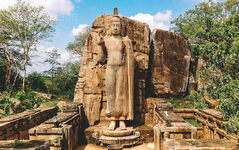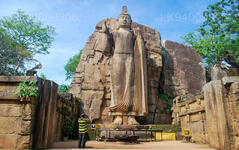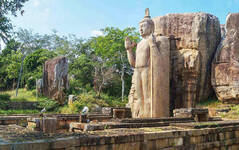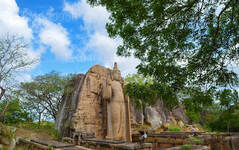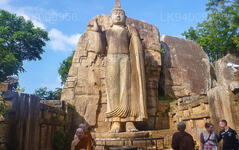
Město Anuradhapura
Anuradhapura patří do severocentrální provincie Srí Lanky. Anuradhapura je jedno ze starobylých hlavních měst Srí Lanky, známé svými dobře zachovalými ruinami starověké lanské civilizace. Město, nyní zapsané na seznamu světového dědictví UNESCO, leží 205 km severně od současného hlavního města Kolomba na Srí Lance.
Aukana Buddha Statue
Aukana Buddha statue is located 30km northwest of Dambulla close to the ancient Kala Weva man-made rainwater reservoir. It can be reached from Kekirawa on Dambulla-Anuradhapura road.
The tallest ancient Buddha statue of Sri Lanka
Aukana Buddha Statue in Sri Lanka that rise to a height of 11.36 meters, is the tallest ancient Buddha statue in Sri Lanka.
The posture of the statue
Aukana Buddha Statue in Asisa Mudra or the “posture of blessing” is carved out of a rock boulder. The statue is carved in the round connected to the back to the rock boulder. The delicate and skillful carving of the Buddha’s robe humanizes and chastely reveals the underlying form of his body, while the face’s impassive expression projects an aura of spiritual supremacy.
It is said that the degree of alignment of the statue is such that raindrop on the nose would drop straight down to a small depression carved between the toes. Aukana Buddha Statue is a masterpiece of a colossal Buddha Statue by an unknown sculptor: the serene expression of the statue, the gracefully carved robe with neat pleats brings in delicateness that could hardly be molded into a rock. The impassive expression of the face reflects the supreme spirituality.
The sculpture in proportion
Aukana Buddha Statue is carved alone in the proportion of nine faces: the body height is nine times the length of the face. The proportion of nine faces is the iconometry followed by the sculptors in the eighth century AC of Sri Lanka.
Sirasapata
Sirasapata is the symbol placed on the top of the Buddha images in Sri Lanka. The sirasapata found on the head of Aukana Buddha statue is believed to be a modern addition in the year 1870. The discovery of a fragment of a sirasapata in the premises of the site suggests there had been a sirasapata on the head of the statue nearly a century before 1870. This turn of events has lead to the study of whether sirasapata had existed from the very beginning in the 8th century AD. According to Buddhist literature, sirasapata have existed in all four previous Buddhas. The introduction and existence of sirasapata have been consistent in Sri Lanka since the second half of the fifth century A.D. with several exceptions. Hence it is believed Aukana Buddha Statue too was adorned with a sirasapata.
Drapery
Drapery, the art of draping the statues in folds is prominent in the Aukana Buddha statue. The robe in single groves is draped over the left shoulder to fall over the left shoulder up to the ankle. The right shoulder is left bare.
Pedestal
Aukana Buddha statue stands on a pedestal, the front of which is carved off a slab of stone in the form of a double petal lotus flower called Padmasana meaning the Lotus seat.
School of Art
Iconography, the study of characteristics of statues, the Avukana Buddha, particularly the sirasapata, pedestal, and the style shows Aukana Buddha statue belongs to Anuradhapura school of art.
Dating Aukana Statue
The difference in opinion of the experts of the dating of Aukana Buddha statues was finally resolved following the discovery in the year 1952, of an inscription on a granite slab built onto the northern wall of the shrine. The statue was sculpted in the second half of the 8th century AD when Mahayana Buddhism threatened to take root in Sri Lanka.
O okrese Anuradhapura
Anuradhapura patří do severocentrální provincie na Srí Lance. Anuradhapura je jedno ze starobylých hlavních měst Srí Lanky, známé svými dobře zachovalými ruinami starověké lanské civilizace. Město, nyní zapsané na seznamu světového dědictví UNESCO, leží 205 km severně od současného hlavního města Kolomba na Srí Lance. V posvátném městě Anuradhapura a jeho okolí se nachází velké množství ruin. Ruiny se skládají ze tří tříd budov: dagoby, klášterní budovy a pokuny (rybníky). Město mělo jedny z nejsložitějších zavlažovacích systémů starověkého světa a nacházelo se v suché zóně země. Správa vybudovala mnoho nádrží k zavlažování půdy. Většina obyvatelstva jsou Sinhálci, zatímco v okrese žijí Tamilové a srílanští Maurové.
O severocentrální provincii
Severocentrální provincie, která je největší provincií v zemi, pokrývá 16 % celkové rozlohy země. Severocentrální provincie se skládá ze dvou okresů zvaných Polonnaruwa a Anuradhapure. Anuradhapura je největší okres na Srí Lance. Jeho rozloha je 7 128 km². Severocentrální provincie má pro investory mnoho potenciálu k zahájení podnikání, zejména v zemědělství, zemědělském průmyslu a chovu hospodářských zvířat. Více než 65 % obyvatel Severocentrální provincie je závislých na základním zemědělství a zemědělském průmyslu. NCP se také nazývá „Wew Bendi Rajje“, protože se v provincii nachází více než 3 000 středních a velkých nádrží. Sri maha bodiya, Ruwanweli seya, Thuparama dageba, klášter Abayagiri, Polonnaruwa Rankot wehera a Lankathilake se bojí...

